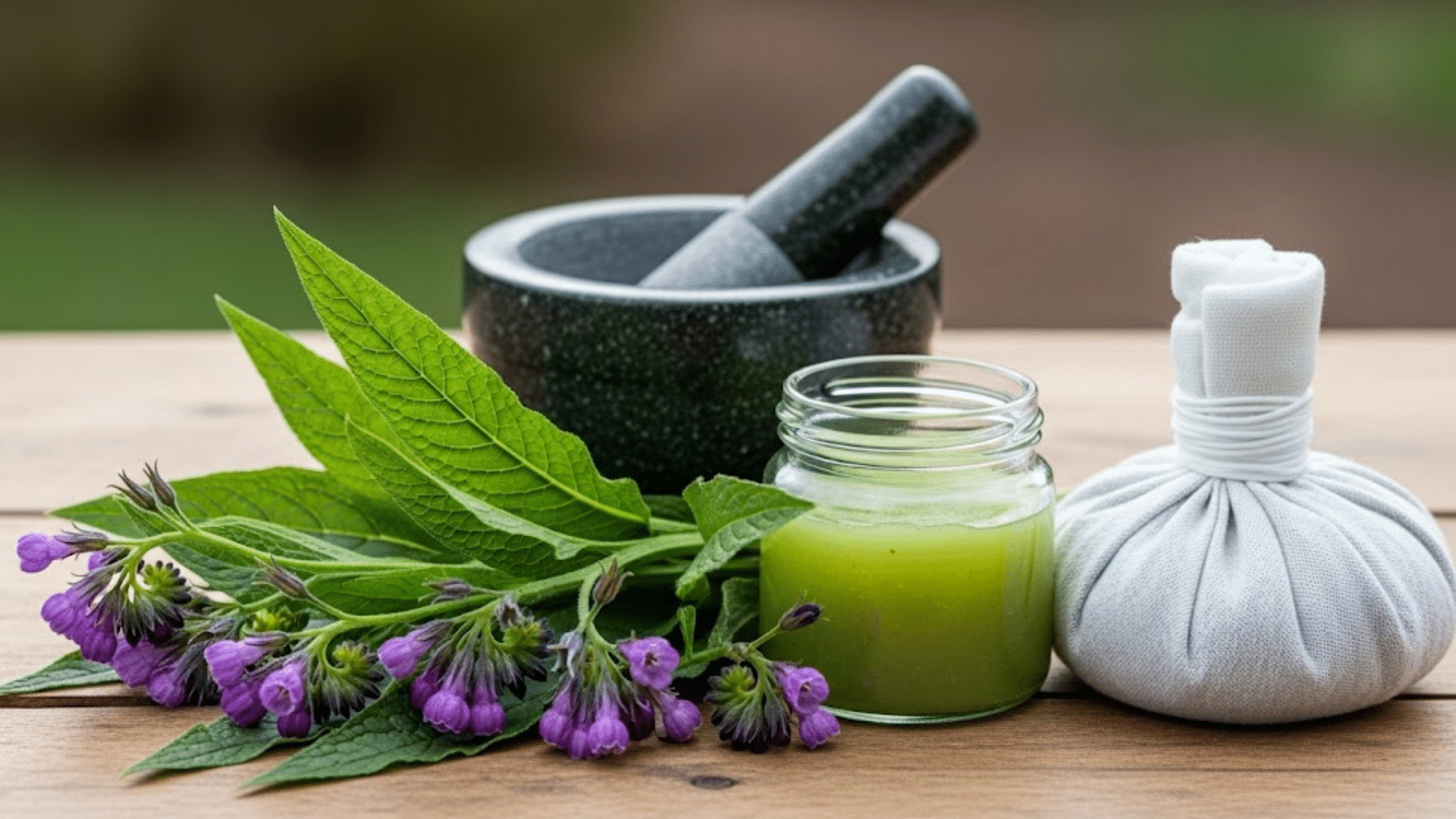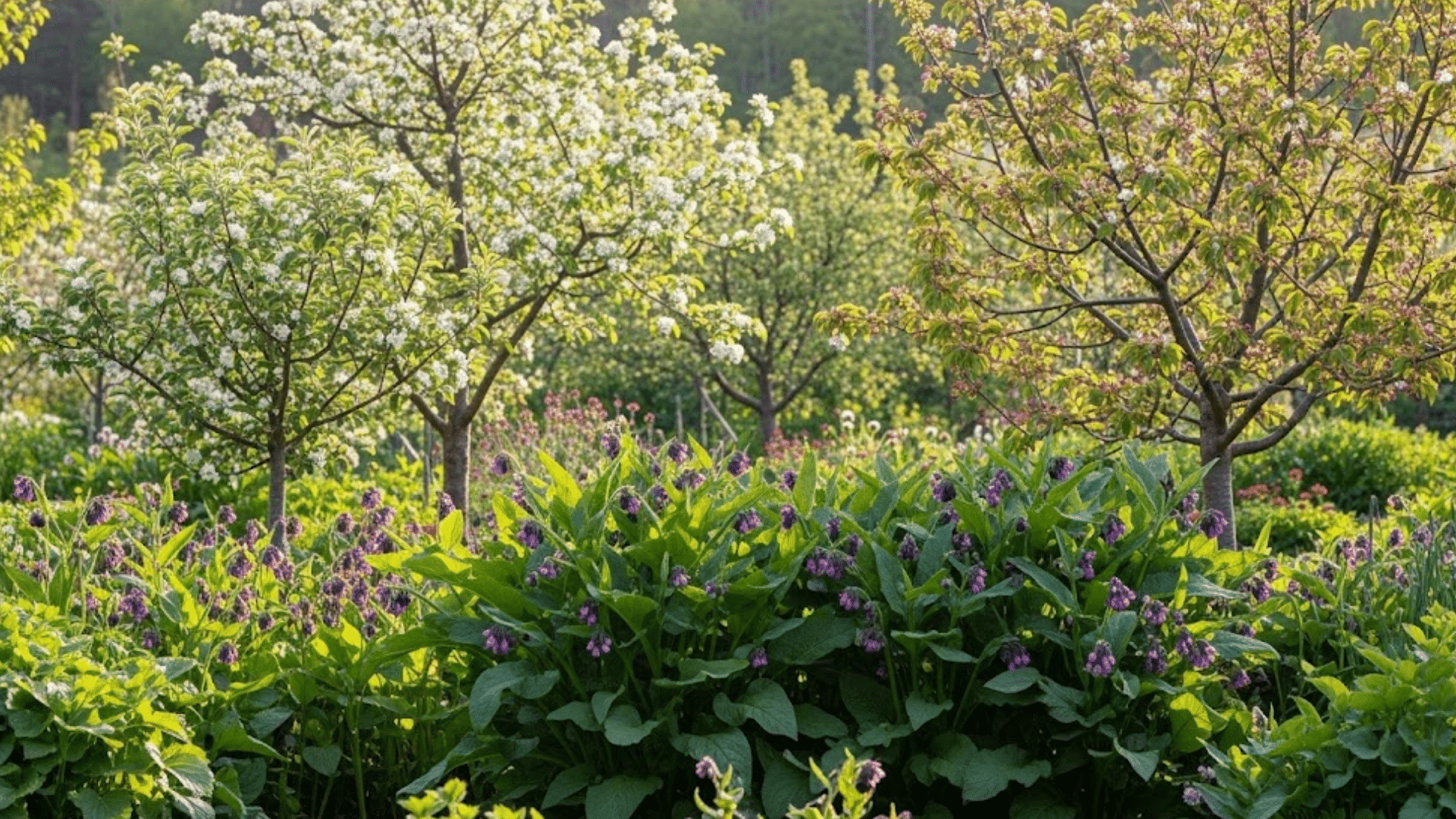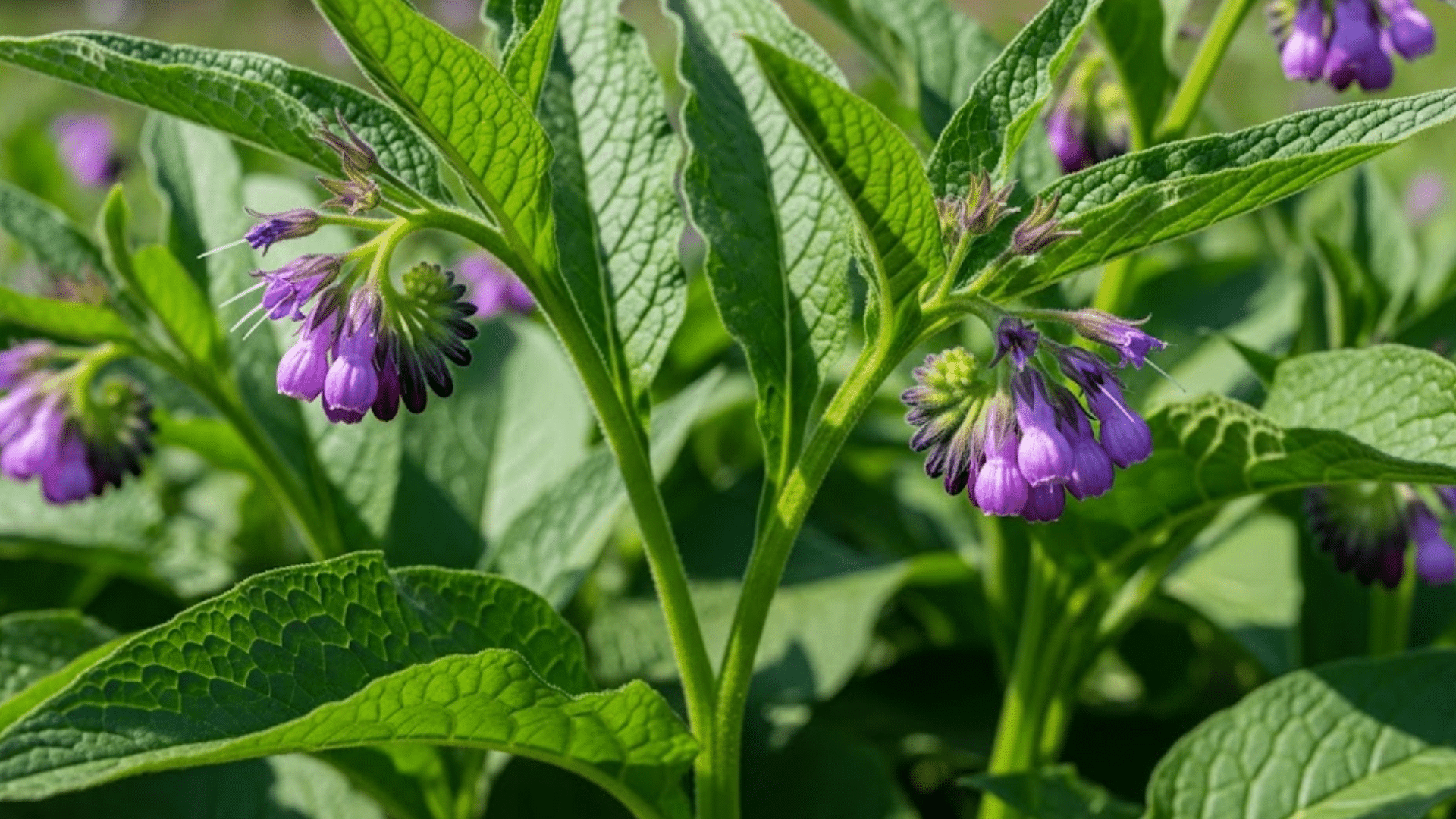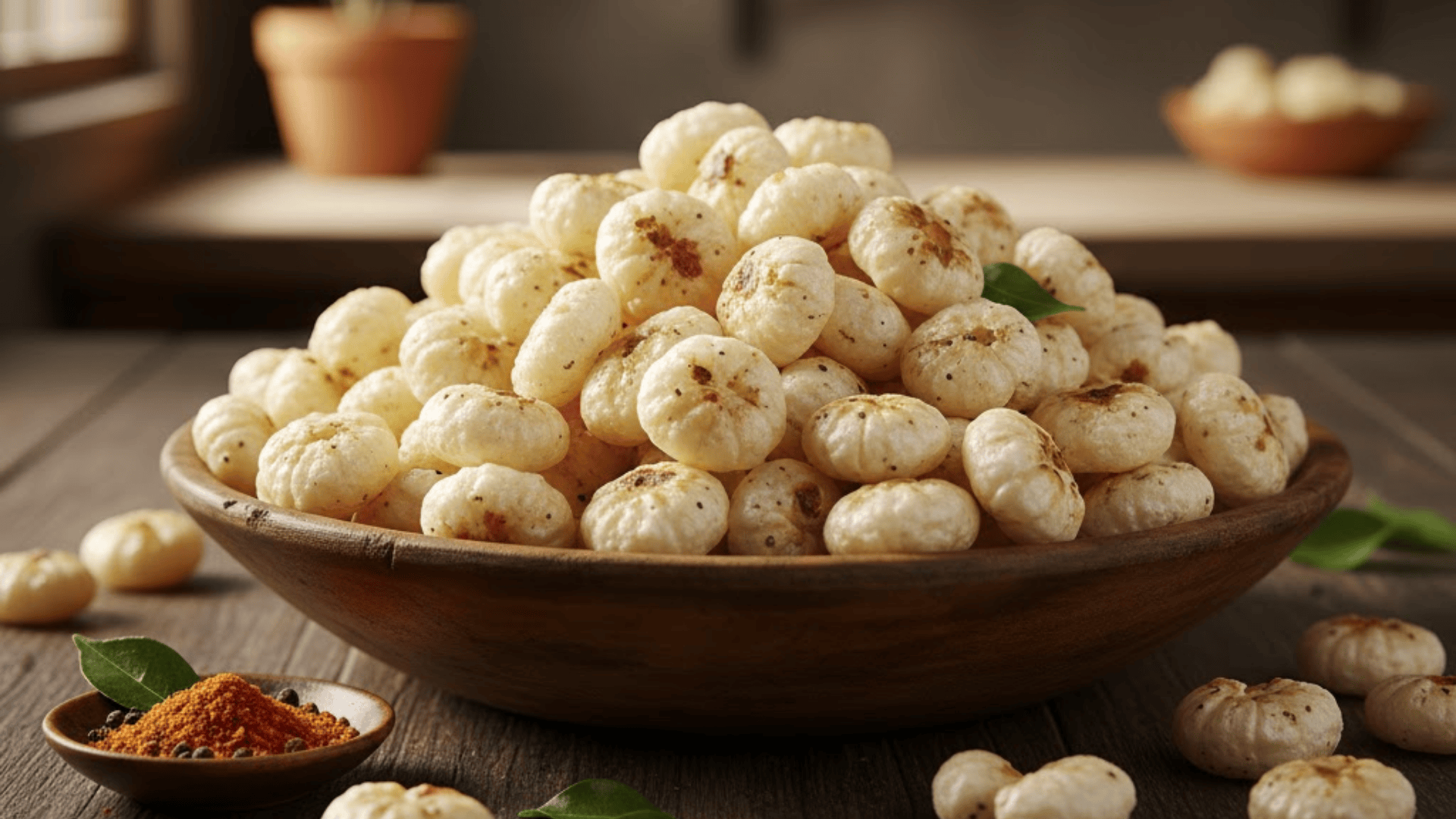Comfrey (Symphytum officinale) has long been revered in traditional medicine for its ability to alleviate pain, support tissue repair and recovery, and promote skin healing.
Beyond its health benefits, Comfrey is also a gardener’s ally, improving soil quality, enriching compost, and attracting pollinators.
I’ll help you find the excellent benefits of Comfrey, including its common uses, gardening value, and essential safety rules.
What is Comfrey?
Comfrey is a leafy herbaceous plant native to Europe and Asia, recognized for its broad leaves and clusters of purple, blue, or white flowers. It thrives in moist, temperate environments and can be easily grown in gardens or natural areas.
Its key active compounds, allantoin and rosmarinic acid, are what give Comfrey its well-known skin-repairing and soothing effects.
Traditionally used in poultices and salves, Comfrey has been known to help relieve a variety of conditions, including bruises, sprains, muscle aches, and rashes.
Today, many of its traditional applications remain effective, with modern research confirming its external benefits, particularly for skin support and relief from local inflammation.
Comfrey Benefits and Traditional Uses


Comfrey uses span centuries of traditional healing, valued for its ability to support the body naturally. Its wide range of applications makes it a trusted remedy in herbal medicine.
1. Wound Healing
Comfrey helps speed up the healing process of minor cuts, bruises, and skin abrasions. Thanks to its allantoin content, it encourages new cell growth and tissue repair.
Used topically, it forms a protective layer over wounds and supports faster skin regeneration without the use of synthetic chemicals.
2. Joint and Muscle Pain Relief
Topical Comfrey creams or poultices can help relieve soreness associated with joint pain, muscle strains, and arthritis.
Its anti-inflammatory properties ease stiffness and discomfort, making it popular among those with osteoarthritis or sports injuries.
It doesn’t treat underlying conditions but provides temporary relief from aches and swelling.
3. Healing Fractures
Historically known as “knitbone,” Comfrey has been used to support bone healing. It contains compounds that stimulate tissue growth and may help fractures heal faster when applied externally.
While it doesn’t replace medical care, it complements recovery by reducing swelling and supporting the repair of bone and connective tissue.
4. Soothing Burns and Skin Irritation
Comfrey offers quick relief from minor burns, sunburns, rashes, and itchy skin. Its cooling, anti-inflammatory effect calms irritated areas and reduces redness.
Many use it in salves or creams for first-aid skin care, especially when dealing with bug bites or mild allergic reactions.
5. Reducing Swelling and Bruising
Applying Comfrey to bruises or swollen areas helps shrink puffiness and discoloration. It boosts circulation to the injured site and helps your body absorb fluids trapped under the skin.
This makes it a reliable choice for sprains, black-and-blue marks, or post-injury care.
6. Muscle Recovery After Exercise
Athletes and active individuals use Comfrey to relax sore muscles after intense workouts. Its natural compounds help ease tightness and support quicker recovery.
Applied as an infused oil or cream, Comfrey can reduce post-exercise fatigue and make muscles feel more flexible and refreshed.
7. Arthritis Support
People with arthritis often use Comfrey topically to ease pain in knees, hands, and other stiff joints. It doesn’t reverse joint damage but reduces everyday discomfort.
Used in combination with heat therapy or massage, it may help improve mobility and quality of life for individuals with arthritis.
8. Minor Insect Bite Treatment
Comfrey’s soothing properties make it ideal for calming itchy, red insect bites. It reduces swelling and helps prevent scratching, which lowers the risk of secondary infection.
Used fresh or in creams, Comfrey promotes faster healing of bug bites and minimizes discomfort.
9. Support for Back or Neck Strain
When applied to areas of tension, such as the lower back or neck, Comfrey may help alleviate stiffness. It penetrates deeply to soothe sore muscles and reduce tightness.
Many use Comfrey salves or compresses after long hours of sitting, heavy lifting, or stress-related muscle tightness.
Comfrey Medicinal Uses and Home Remedies
Comfrey has been used for centuries in home settings to treat common skin and muscle issues. Here are a few easy ways to apply it:
- Poultices and Topical Applications: Crush fresh or dried Comfrey leaves and apply them directly to bruises, sprains, or sore muscles. You can also use it in pre-made creams or ointments for convenience.
- Comfrey Oil: Comfrey oil is made by infusing Comfrey leaves and roots into a neutral oil. It’s known for its soothing properties and can be used to relieve muscle pain, joint inflammation, and skin irritation. It’s also commonly used for healing minor cuts, burns, and insect bites.
- Comfrey Tea for Houseplants: For gardening enthusiasts, Comfrey tea can be a great way to provide nutrients to houseplants. Simply soak dried Comfrey leaves in water for 24 hours and strain the mixture. Use the liquid as a natural fertilizer to improve soil quality.
Safety Precautions and Side Effects of Comfrey
While Comfrey offers natural relief for many issues, it must be used with care. Here are essential safety notes:
- Do not ingest Comfrey. It contains pyrrolizidine alkaloids (PAs), which can cause serious liver damage.
- Avoid topical use on broken or damaged skin, as toxins can be absorbed more easily.
- Some people may experience skin irritation or allergic reactions, such as rashes or itching.
- Do not use during pregnancy or breastfeeding due to potential risks from skin absorption.
- People with liver conditions should avoid Comfrey completely.
- Limit external use to less than six weeks to prevent skin sensitivity or toxin buildup.
- Always consult a healthcare provider before using Comfrey, especially if you have a pre-existing health condition or are taking any medications.
Understanding the risks ensures the safe and effective use of a product without unwanted side effects.
Comfrey’s Role in Gardening


Comfrey is a powerful and versatile addition to any garden, offering multiple benefits that improve both soil quality and overall plant health.
Rich in potassium, Comfrey leaves can be used as mulch around fruit trees and garden beds, slowly breaking down to release nutrients that enrich the soil.
Its high nitrogen content also makes Comfrey ideal for composting, adding the leaves to your compost heap boosts its nutritional value and promotes faster decomposition.
Since the plant can be harvested multiple times a year without damage, it provides a steady, renewable source of composting material.
Beyond soil benefits, Comfrey plays a vital role in supporting pollinators. Its nectar-rich flowers attract bees and other beneficial insects, which help pollinate surrounding plants and maintain a thriving garden ecosystem.
Government and Legal Restrictions Around Comfrey Use
Comfrey is legally restricted in many countries because it contains pyrrolizidine alkaloids (PAs), which can cause serious liver damage and are potentially carcinogenic.
The U.S. FDA bans all oral Comfrey products, and European authorities only allow topical use on intact skin with strict limitations.
While some regions permit topical Comfrey creams or ointments, these should not be used on broken skin or for extended periods.
All health agencies warn against ingesting Comfrey in any form, urging people to follow local regulations and consult a healthcare professional before any use.
Conclusion
Comfrey benefits for both natural healing and sustainable gardening. Its external uses, such as easing joint pain, soothing skin, and supporting recovery, make it a popular choice in herbal care.
In the garden, it enriches soil, supports composting, and attracts pollinators. Despite these advantages, it must be used with care.
Due to its toxic compounds, internal use is unsafe, and topical application should be limited and monitored.
Understanding how to use it safely ensures you reap its benefits without risk. If you’re treating a sore muscle or boosting your garden’s health, Comfrey can be helpful when handled responsibly.
For more insights into natural healing and eco-friendly gardening, be sure to check out my other blog posts.











